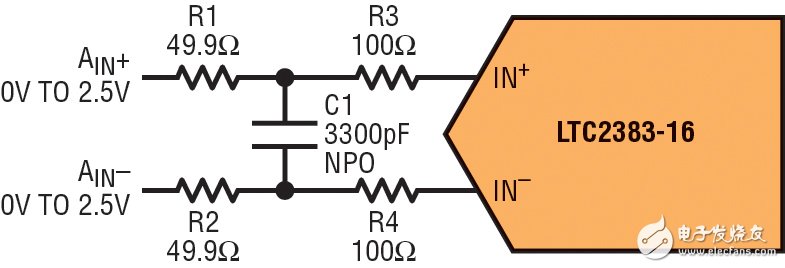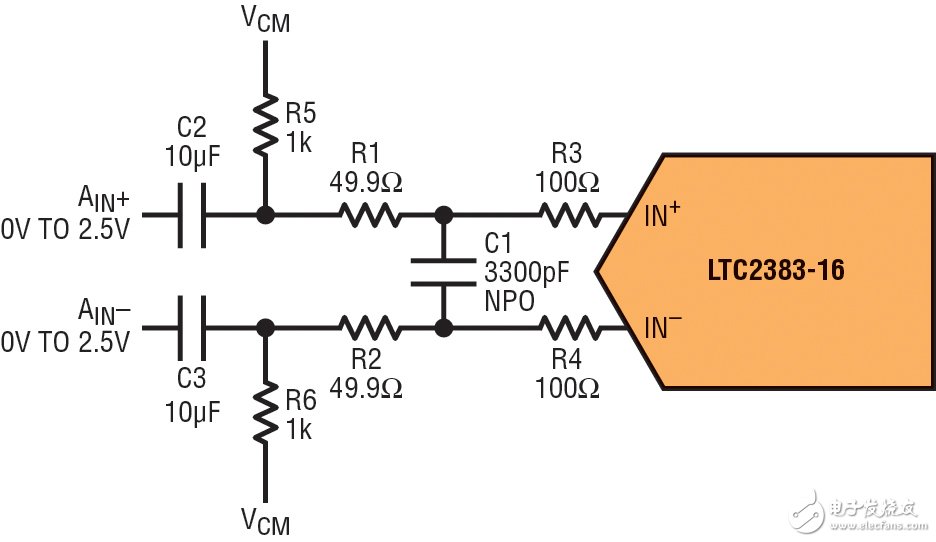How to drive low power 16-bit ADCs with multiple single-ended signals
Matching sensor output and ADC input range can be difficult, especially when faced with multiple output voltage swings generated by today's sensors. This article provides a simple but high performance ADC input driver solution for differential, single-ended, unipolar, and bipolar signals with varying ranges. All circuits in this article use the LTC2383-16 ADC to work alone or with the LT6350 ADC driver. To achieve 92dB SNR.
The LTC2383-16 is a low noise, low power, 1Msps, 16-bit ADC with a ±2.5V fully differential input range. The LT6350 is a rail-to-rail input and output, low noise, low power single-ended to differential converter/ADC driver with fast settling time. With the LT6350, the single-ended input range of 0V to 2.5V, 0V to 5V, and ±10V can be easily converted to the ±2.5V fully differential input range of the LTC2383-16.
Fully differential drive
Figure 1 shows the basic components used for all of the circuits described herein. This basic component is used for DC-coupled fully differential signals to the LTC2383-16 analog input. Resistors R1, R2 and capacitor C1 limit the input bandwidth to approximately 500 kHz. Resistors R3 and R4 mitigate the effects of the ADC input sampling spike, which can interfere with the sensor or ADC driver input.

Figure 1: Fully differential drive circuit
This circuit is useful for sensors with low impedance differential outputs. The common-mode voltage driving AIN+ and AIN– must be equal to VREF/2 to meet the common-mode input range requirements of the LTC2383-16.
The circuit in Figure 1 can be AC-coupled to match the common-mode voltage of the ADC input to the sensor when necessary. Simply bias AIN+ and AIN– to VCM (VCM=VREF/2) through a 1k resistor and couple the sensor output to AIN+ and AIN– through a 10μF capacitor, as shown in Figure 2.

Figure 2: AC coupled fully differential drive circuit
When driving a low noise, low distortion ADC such as the LTC2383-16, choosing the right component is critical to maintaining high performance. The values ​​of all resistors used in these circuits are relatively low. This keeps the noise low and the short settling time. Metal thin film resistors are recommended to reduce distortion caused by self-heating. C1 uses NPO capacitors because they have a low voltage coefficient to minimize distortion.
Shareconn development Co.,Ltd always offer good quality RF Cable Assemblies, we often keep some commonly RF Coaxial Cable at our factory, such as RG174, RG178, RG179,RG316 and simi-rigid coaxial cables and so on.
We offer you GPS/GSM/3G and WLAN/WiMax RF coaxial cables, RF/coaxial Connectors, antenna Adapter cables and cable assemblies. So whether you need products for use in television broadcasting, satellite communication and other fields, we have what you are looking for.
Ensuring Quality Through In-house Production
From design to production, all processes are carried out in our factory. This enables us to closely monitor the quality of all our products - compared to our competitors who outsource their production and have little control over QC.
For more information, contact us today.
RF Jumper Cables,Flexible RF Jumper Cables,Super Flexible RF Jumper Cables,RF Jumper Coaxial Cable
Shareconn Development CO.,LTD , http://www.share-conn.com